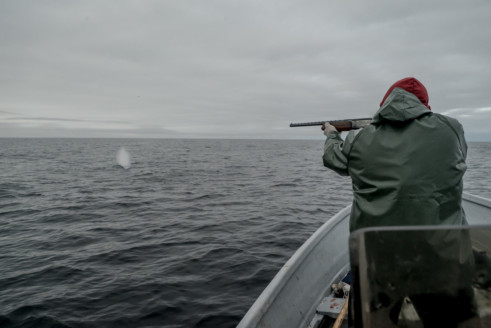
BONAVISTA, Newfoundland
Shannon Mouland steadied himself in an aluminium boat, shotgun raised, as a thick-billed murre skittered above the slate-grey waters of the North Atlantic.
Boom! And the bird cartwheeled into the sea.
It’s “turr” season on The Rock, as this massive inkblot of an island is affectionately known. Turr is the local name for the murre, which looks something like a diminutive, flying penguin, and men in boats are blasting away at it in the only legal, non-aboriginal hunt of migratory seabirds in North America.
The pastime harks back to the days when Newfoundlanders supplemented meagre winter diets with fresh meat on the wing, eating everything from clownish puffins to the great northern gannet. Conservation efforts gradually put most of the island’s estimated 350 seabird species off limits. But the taste for turr was so entrenched that allowing the hunt to continue became a precondition for Newfoundland to join Canada in 1949.
“Our fathers would come back with the boats piled high with turr,” Mouland recalled, gripping a green rope to steady himself as the boat hammered over the steely waves.
Here along Newfoundland’s treeless, surf-pounded coast, hardy men (and some women) rise before dawn and motor their boats out into the open sea in search of the birds that come to feed on small forage fish. They are remarkable animals, spending most of their lives on the ocean and visiting land only to pack tightly together on the rocky cliffs of northeastern Canada and Greenland for a few months each summer while the females lay their one speckled blue egg.
Birds that swim
The murres’ short wings act as flippers underwater, allowing them to swim nimbly and swiftly in search of fish. They are the deepest-diving flying birds in the world, capable of plummeting as deep as 182 metres in little more than a minute. But those wings make them less agile in the air and slow to take off from the water, leaving them an easy target for hunters.
“Turr!” Mouland shouted, pointing to his left, and Jerry Hussey, clad in a forest green slicker and matching overalls, swung the boat toward a small black-and-white bird bobbing in the waves 30 metres away. Boom, again.
Mouland picked the bird out of the water and whacked its head against the gunwale to ensure that it was dead. Before long, a plastic bin in the boat was lined with the birds, their snowy white breasts and sleek coal-black heads flecked with blood.
The Canadian Wildlife Service estimates that 100,000 murres are killed in the hunt each year. But the common murre population in Canada has increased over the past 15 years, while the thick-billed murre population remains stable. There are millions more murres elsewhere, making the genus one of the Artic’s most abundant seabirds.
But as the hunt intensifies, many people are beginning to ask whether the annual cull needs better regulation.
In the old days, men hunted murres in rowboats with muzzleloading shotguns, sending their dogs into the frigid water to fetch the fallen prey. Now, many hunters have fibreglass-hulled boats that cut through sea ice, and high-horsepower outboard engines that can move boats faster than the birds. The murre hunt has a long tradition in Newfoundland, where seabirds, from great auks to eiders, provided sailors with much-needed protein after the long voyage from Europe. Eating seabirds and seals later sustained coastal populations through Newfoundland’s long, frozen winters.
Source of protein
Murres and eiders were the most available sources of winter protein until the 1960s, when electricity and refrigeration changed eating habits. Before then, some families consumed as many as 400 birds a year. When Newfoundland became a province, it fell under the Migratory Bird Treaty between the US and Canada, which would have outlawed the hunt if the two countries had not agreed to let it continue. The treaty was finally amended in the 1990s to specifically grant Newfoundland residents the right to hunt murres. Under the treaty, hunters must buy permits, and Canada’s environmental protection agency carved Newfoundland into four zones with progressively later murre hunting seasons that run from September to March. The regulations set a 20-bird limit on what each hunter can kill in a day, and a 40-bird limit on how many a hunter can possess at one time. But enforcement is lax, and abuses are common.
Newfoundlanders are well aware of the dangers of overexploitation. A mariner, Sir Richard Whitbourne, wrote in 1622 that great auks, a flightless relative of the murre, were found in “infinite abundance” along the Newfoundland coast. But by the mid-19th century, the birds had been clubbed to extinction, their feathers used to stuff mattresses. The less numerous Labrador duck and Eskimo curlew suffered the same fate.
—New York Times News Service














